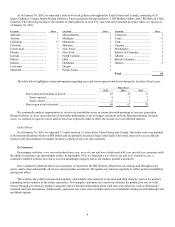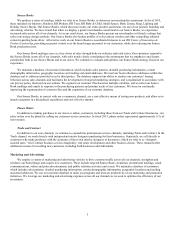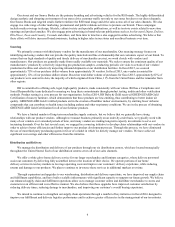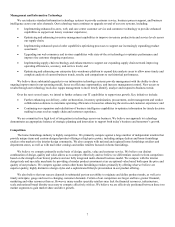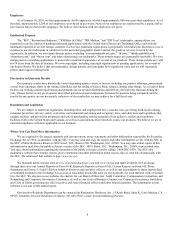Restoration Hardware 2015 Annual Report Download - page 16
Download and view the complete annual report
Please find page 16 of the 2015 Restoration Hardware annual report below. You can navigate through the pages in the report by either clicking on the pages listed below, or by using the keyword search tool below to find specific information within the annual report.13
If we fail to successfully anticipate consumer preferences and demand our results of operations may be adversely affected.
We are vulnerable to customer preferences and demand. Our success depends in large part on our ability to originate and define
home product trends, as well as to anticipate, gauge and react to changing consumer demands in a timely manner. Our products must
appeal to a range of consumers whose preferences cannot always be predicted with certainty. We cannot assure you that we will be
able to continue to develop products that customers positively respond to or that we will successfully meet consumer demands in the
future. Any failure on our part to anticipate, identify or respond effectively to consumer preferences and demand could adversely
affect sales of our products, which could have a material adverse effect on our financial condition and results of operations.
If we fail to successfully and timely deliver merchandise to our customers and manage our supply chain commensurate with
demand, our results of operations may be adversely affected.
We must successfully manage our supply chain and vendors in order to produce sufficient quantities of products that our
customers wish to purchase in a timely manner. We must manage our supply chain and inventory levels, including predicting the
appropriate levels and type of inventory to stock within each of our distribution centers, such that our “in stock” position in
merchandise correlate well to consumer demand and expected delivery times. Because much of our merchandise requires that we
provide vendors with significant ordering lead times, frequently before market factors are known, we may not be able to source
sufficient inventory to meet demand if our products prove more popular than anticipated. From time to time, we have experienced
periods in which some of our vendors were not able to meet customer demand levels for certain products resulting in significant back
orders for goods, higher rates of cancellation on orders in process and, in some instances, the loss of customer sales when orders could
not be completed in a timely manner. Further, the seasonal nature of some of our products requires us to carry a significant amount of
inventory prior to certain selling seasons. If we are unable to accurately predict and track demand, we may be required to mark down
the price of certain products in order to sell excess inventory or we may be required to sell such inventory through our outlet stores or
warehouse sales. For these reasons, our results of operations in any given quarterly period may be adversely affected. We expect these
factors to continue from time to time as we add new product assortments and new merchandise categories into our business.
We are subject to risks associated with our dependence on foreign manufacturing and imports for our merchandise.
Based on total volume dollar purchases, in fiscal 2015 we sourced approximately 89% of our merchandise from outside the
United States, including 82% from Asia, the majority of which originated from China. In addition, some of the merchandise we
purchase from vendors in the United States also depends, in whole or in part, on vendors located outside the United States. As a result,
our business highly depends on global trade, as well as trade and cost factors that impact the specific countries where our vendors are
located, particularly Asia. Our future success will depend in large part upon our ability to maintain our existing foreign vendor
relationships and to develop new ones as well as the ability of our vendors to scale their operations commensurate with demand from
our customers, which in some cases will require substantial ongoing investments to support additional capacity. While we rely on our
long-term relationships with our foreign vendors, we have no long-term contracts with them and transact business on an order-by-
order basis. Additionally, many of our imported products are subject to existing duties, tariffs, anti-dumping duties and quotas that
may limit the quantity of some types of goods that we import into the United States.
Our dependence on foreign imports also makes us vulnerable to risks associated with products manufactured abroad, including,
among other things, risks of damage, destruction or confiscation of products while in transit to our distribution centers located in the
United States, charges on or assessment of additional import duties, tariffs, anti-dumping duties and quotas, loss of “most favored
nation” trading status by the United States in relation to a particular foreign country, work stoppages, including without limitation as a
result of events such as longshoremen strikes, transportation and other delays in shipments, including without limitation as a result of
heightened security screening and inspection processes or other port-of-entry limitations or restrictions in the United States, freight
cost increases, economic uncertainties, including inflation, foreign government regulations, trade restrictions, including the United
States retaliating against protectionist foreign trade practices and political unrest, increased labor costs and other similar factors that
might affect the operations of our vendors in specific countries such as China.
An interruption or delay in supply from our foreign sources, or the imposition of additional duties, taxes or other charges on
these imports, could have a material adverse effect on our business, financial condition and results of operations unless and until
alternative supply arrangements are secured.



